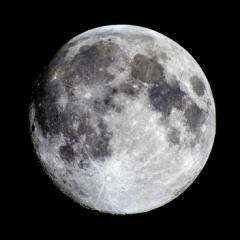January 28, 2010 report
The Moon may have formed in a nuclear explosion

(PhysOrg.com) -- A new theory suggests the Moon was formed after a natural nuclear explosion in the Earth's mantle rather than after the impact of a massive object with the Earth, as previously thought.
The problem with the impact hypothesis is that simulations calculate the Moon should be composed of 80% impactor and 20% Earth, whereas in fact the isotope ratios of light and heavy elements found in Moon rocks so far examined are virtually identical to those on Earth.
The fission hypothesis is an alternative explanation for the formation of the moon, and it predicts similar isotope ratios in the Moon and Earth. The hypothesis (credited to Charles Darwin’s son George in 1879) is that the Earth and Moon began as a mass of molten rock spinning rapidly enough that gravity was just barely greater than the centrifugal forces. Even a slight kick could dislodge part of the mass into orbit, where it would become the Moon. The hypothesis has been around for 130 years, but was rejected because no one could explain a source of the energy required to kick a moon-sized blob of molten rock into orbit.
Dutch scientists Rob de Meijer (University of the Western Cape) and Wim van Westrenen (Amsterdam’s VU University) think they know the answer. Their hypothesis is that the centrifugal forces would have concentrated heavy elements like thorium and uranium on the equatorial plane and at the Earth core-mantle boundary. If the concentrations of these radioactive elements were high enough, this could have led to a nuclear chain reaction that became supercritical, causing a nuclear explosion.
De Meijer and van Westrenen calculate the concentration of radioactive elements could have been high enough for a supercritical nuclear reaction to take place. After it became supercritical the Earth basically became a natural nuclear georeactor that exploded and ejected into orbit the lunar-sized blob that became the Moon.
The researchers suggest the hypothesis explains the identical isotopic composition of light and heavy elements, and further propose it could be tested, since the explosion would leave evidence such as xenon-136 and helium-3, which would have been produced in abundance in the georeactor. Confirmation will be complicated by the fact that solar wind deposits these isotopes onto the moon in vast quantities, and that would have to be compensated for.
Georeactors are known to have existed on Earth, such as that at Oklo in the Republic of Gabon in Western Africa, which was operating between 2.0 and 1.5 billion years ago.
More information: arxiv.org/abs/1001.4243
© 2010 PhysOrg.com
















